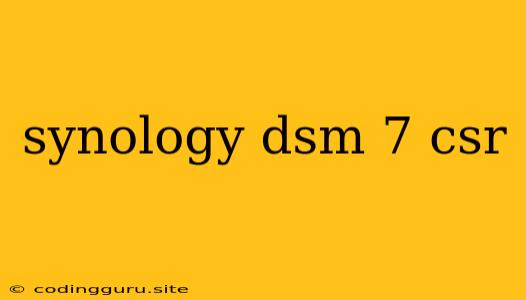Synology DSM 7 and CSR: A Comprehensive Guide
Synology DiskStation Manager (DSM) is a powerful operating system designed for Synology NAS devices. With its constant updates and feature additions, DSM 7 offers a vast range of functionalities, including secure communication through SSL certificates. Obtaining and configuring a CSR (Certificate Signing Request) is an essential step in enabling this security feature.
What is a CSR?
A Certificate Signing Request (CSR) is a file that contains information about your Synology NAS and serves as a request to a Certificate Authority (CA) for an SSL certificate. This information includes details like your domain name, organization name, location, and public key.
Why Do I Need a CSR?
A CSR is crucial for the following reasons:
- Secure Communication: It enables secure communication between your Synology NAS and your clients by encrypting data transmitted between them.
- Website Trust: An SSL certificate, generated from a CSR, helps establish trust with visitors to your website by verifying your identity and securing your connection.
- Data Protection: It protects sensitive data, like passwords and personal information, from interception and unauthorized access during transmission.
How to Generate a CSR on Synology DSM 7?
Generating a CSR on your Synology DSM 7 is a straightforward process:
- Log in to DSM: Access the DSM interface using your credentials.
- Navigate to Security: In the DSM main menu, find the "Security" option and click it.
- Open Certificate: Select "Certificate" from the left-hand menu within the "Security" section.
- Create a CSR: Click on the "Create" button and choose "Certificate Signing Request (CSR)" from the dropdown menu.
- Fill in the Form: Provide the necessary details, including your domain name, organization name, location, and contact information.
- Generate CSR: Click on "Generate CSR."
- Download CSR: Download the generated CSR file in .csr format. This file will be used to request an SSL certificate from a Certificate Authority.
Tips for Generating a CSR
- Accurate Information: Double-check that all the information you enter is accurate, as mistakes can lead to difficulties in getting a valid certificate.
- Domain Name: Use the correct domain name, including any subdomains that you want to secure.
- Organization Details: Provide complete details about your organization, as this information will be displayed in the certificate.
- Contact Information: Enter valid email addresses and phone numbers as this will be used for communication purposes.
Obtaining an SSL Certificate
Once you have generated your CSR, you can submit it to a Certificate Authority (CA) like Let's Encrypt, Comodo, or DigiCert.
- Choose a Certificate Authority: Select a CA that meets your needs and budget.
- Submit the CSR: Submit the CSR file and any required documentation to the CA.
- Verification: The CA will verify your ownership of the domain by sending an email or displaying a code on your website.
- Receive the Certificate: After verification, the CA will issue your SSL certificate.
Installing the SSL Certificate on DSM 7
After acquiring the SSL certificate from the CA, you need to install it on your Synology DSM 7:
- Open Certificate: Go to the "Security" section and select "Certificate" as you did while creating the CSR.
- Import Certificate: Click on the "Import" button and choose "Certificate" from the dropdown menu.
- Select the Certificate: Select the SSL certificate file you received from the CA. This file will typically be in .crt or .pem format.
- Provide Private Key: If necessary, you will also need to provide the private key file associated with the certificate, which is usually in .key format.
- Confirm Import: Click "OK" to confirm the import of the certificate.
Troubleshooting
If you encounter difficulties with the process, here are some common issues and solutions:
- Incorrect Information: Verify that you have entered all the required information accurately.
- CSR Format: Ensure that the CSR file is in the correct format and contains all necessary data.
- Private Key: If you are using a private key, ensure that it matches the certificate you are importing.
- Certificate Authority: Contact the CA you are using for assistance if you experience problems with the verification process or certificate issuance.
Conclusion
Obtaining and installing an SSL certificate on your Synology DSM 7 is essential for securing your NAS and your website. Generating a CSR, submitting it to a CA, and installing the resulting certificate are relatively straightforward processes. By following these steps, you can ensure secure communication and data protection for your Synology NAS and its connected services.
